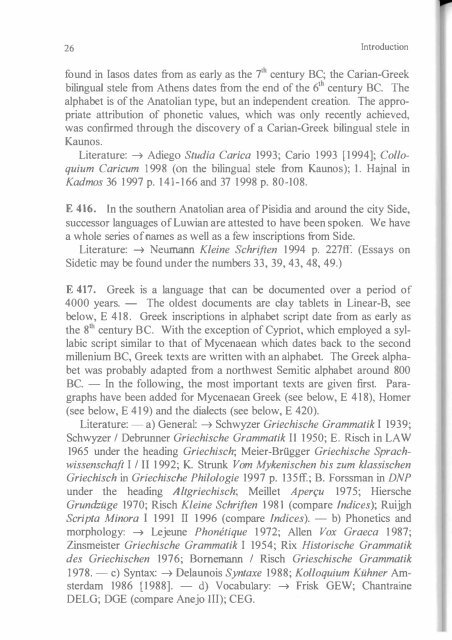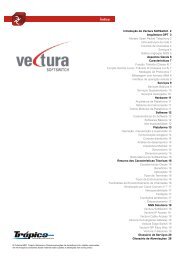Create successful ePaper yourself
Turn your PDF publications into a flip-book with our unique Google optimized e-Paper software.
26 Introductionfo und in lasos dates from as early as the 7" century BC; the Carian-Greekbilingual stele from Athens dates from the end <strong>of</strong> the 6" century BC. Thealphabet is <strong>of</strong> the Anatolian type, but an independent creation. The appropriateattribution <strong>of</strong> phonetic values, which was only recently achieved,was confirmed through the discovery <strong>of</strong> a Carian-Greek bilingual stele inKaunos.Literature: ---7 Adiego Studia Carica 1993; Cario 1993 [1994]; ColloquiumCaricum 1998 (on the bilingual stele from Kaunos); 1. Hajnal inKadmos 36 1997 p. 141-166 and 37 1998 p. 80-108.E 416. In the southern Anatolian area <strong>of</strong> Pi sidi a and around the city Side,successor languages <strong>of</strong>Luwian are attested to have been spoken. We havea whole series <strong>of</strong>narnes as well as a few inscriptions from Side.Literature: ---7 Neumann Kleine Schriften 1994 p. 227ff. (Essays onSidetic may be found under the numbers 33, 39, 43, 48, 49.)E 417. Greek is a language that can be documented over a period <strong>of</strong>4000 years. - The oldest documents are clay tablets in Linear-B, seebelow, E 418. Greek inscriptions in alphabet script date from as early asthe 8" century BC. With the exception <strong>of</strong> Cypriot, which employed a syllabicscript similar to that <strong>of</strong> Mycenaean which dates back to the secondmillenium BC, Greek texts are written with an alphabet. The Greek alphabetwas probably adapted from a northwest Semitic alphabet around 800BC. - In the following, the most important texts are given first. Paragraphshave been added for Mycenaean Greek (see below, E 418), Homer(see below, E 419) and the dialects (see below, E 420).Literature: - a) General: ---7 Schwy2er Griechische Grammatik I 1939;Schwyzer / Debrunner Griechische Grammatik II 1950; E. Risch in LAW1965 under the heading Griechisch; Meier-BrUgger Griechische SprachwissenschaJtI / 11 1992; K. Strunk Vom Mykenischen bis zum klassischenGriechisch in Griechische Philologie 1997 p. 135ff.; B. Forssman in DNPunder the heading Altgriechisch; Meillet Apert;u 1975; HierscheGrundzuge 1970; Risch Kieine Schriften 1981 (compare Indices); RuijghScripta Minora I 1991 IT 1996 (compare Indices). - b) Phonetics andmorphology: ---7 Lejeune Phomitique 1972; Alien Vox Graeca 1987;Zinsmeister Griechische Grammatik I 1954; Rix Historische Grammatikdes Griechischen 1976; Bomemann / Risch Grieschische Grammatik1978. - c) Syntax: ---7 Delaunois Syntaxe 1988; Kolloquium Kuhner Amsterdam1986 [1988]. - d) Vocabulary: ---7 Frisk GEW; ChantraineDELG; DGE (compare Anejo 1II); CEG.Overview <strong>of</strong> the lndo-European Languages and their Sources 27E 418. The earliest written evidence <strong>of</strong> Greek that has survived, is comprised<strong>of</strong> inscriptions in a syllabic script ("Linear B"). The oldest knowndocument comes from the area around Olympia, contains the proper nounKharokws (compare the Homeric XapoljI), and dates from 1650 BC: ---7 P.Arapogianni, J. Rambach, L. Godard in Floreant Sludia Mycenaea I 1995[1999] p. 39-43. Part <strong>of</strong> the clay tablets from Knossos originate in the 14"century BC, the rest are dated around 1200 BC. Aside from Knossos onCrete, mainland sites include palaces in Pylos, Mycenae, Tiryns, and (inBoetia) Thebes. The language <strong>of</strong> the inscriptions is referred to as MycenaeanGreek or simply as Mycenaean. This early phase <strong>of</strong> Greek came tobe a fo cus <strong>of</strong> research only in 1952, after Michael Ventris, along with J.Chadwick, deciphered Linear-B script. It is notable that Greek linguisticshas only been able to integrate Mycenaean material in its discussion sincethe 60s. A textbook such as Schwyzer's Griechische Grammalik I 1939can certainly maintain particular assertions that were at the time thinkable,but which today may no longer be maintained, fo r example the fonnerlycommon analysis <strong>of</strong> EVEKa 'because' < "en-!!eka 'with regard to the will,'which because <strong>of</strong> Mycenaean e-ne-ka, i.e. eneka must be rejected (In thecase <strong>of</strong> "en!!eka, "e-we-ka would be expected!). The questionable EvEKamust now be seen as the fo ssilized root word "",lIeK-", in the accusativesingular case, which means 'for the attainment <strong>of</strong> (with a genitive complement)':---7 Meier-BrUgger Griechische SprachwissenschaJt I 1992 p. 88f.Literature: ---7 SMID; Chadwick Documents 1973; Hiller / PanaglFriihgr. Texte aus myk. Zeil 1976; Aura Jorro Diccionario micenico. I1985 IJ 1993; Meier-BrUgger Griechische SprachwissenschaJt I 1992 p.43ff.; Hooker Linear B 1980; Lejeune Memoires I-IV 1958-1997. - Thelast colloquia: ---7 Colloquium Mycenaeum 1975 [1979]; Res Mycellaeae1981 [1983]; Tractala Mycenaea 1985 [1987]; Mykenaika 1990 [1992];Floreant Studio Mycenaea 1995 [1999]. - Concerning new finds in Thebes:---7 V. Aravantinos in Floreant Studia Mycenaea I p. 45ff. Further,compare the CRAI-Iectures by L. Godart and A. Sacconi: Les dieux Ihebainsdans les archives myceniennes in volume 1996 p. 99-1 13; Les archivesde Thebes et le monde mycenien in volume 1997 p. 889-906; Lageographie des elals myceniens in volume XX 1999 p. 527-546E 419. The first Ancient Greek literary texts are the two epics by Homer;the Iliad and the Odyssey, the writing <strong>of</strong> which is probably correctly datedto the 8th century BC. The oldest evidence <strong>of</strong> the written transmittal <strong>of</strong>these texts are papyri from the third century BC. Although there hadprobably been a couple <strong>of</strong> editions before this date, well into the Hellenis-





